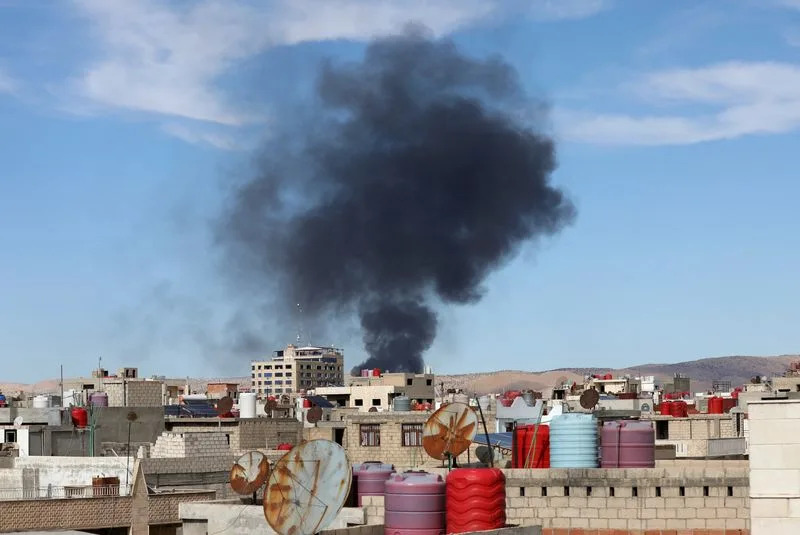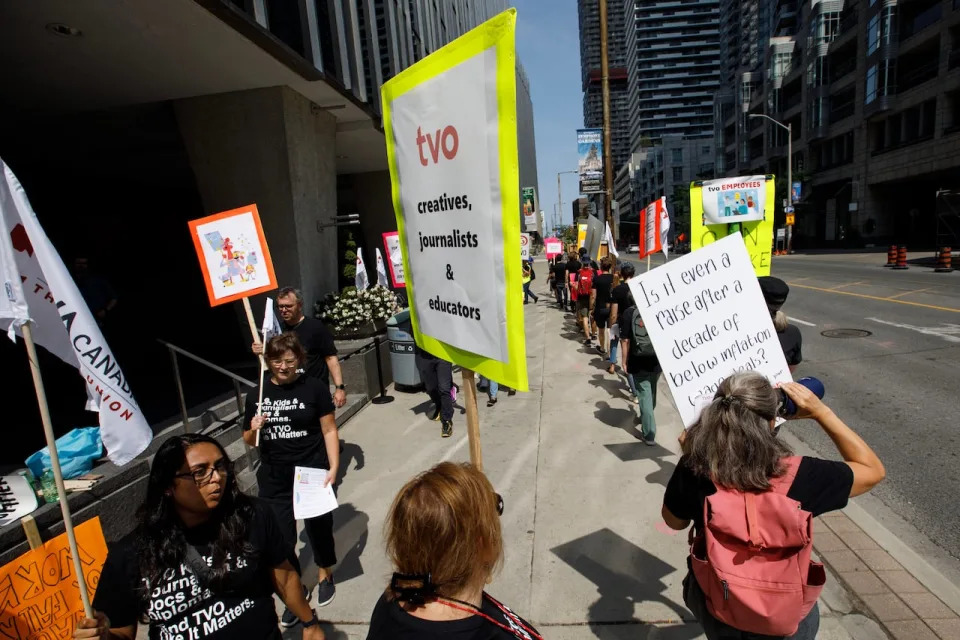Selcan Hacaoglu and Firat Kozok
Fri, October 6, 2023
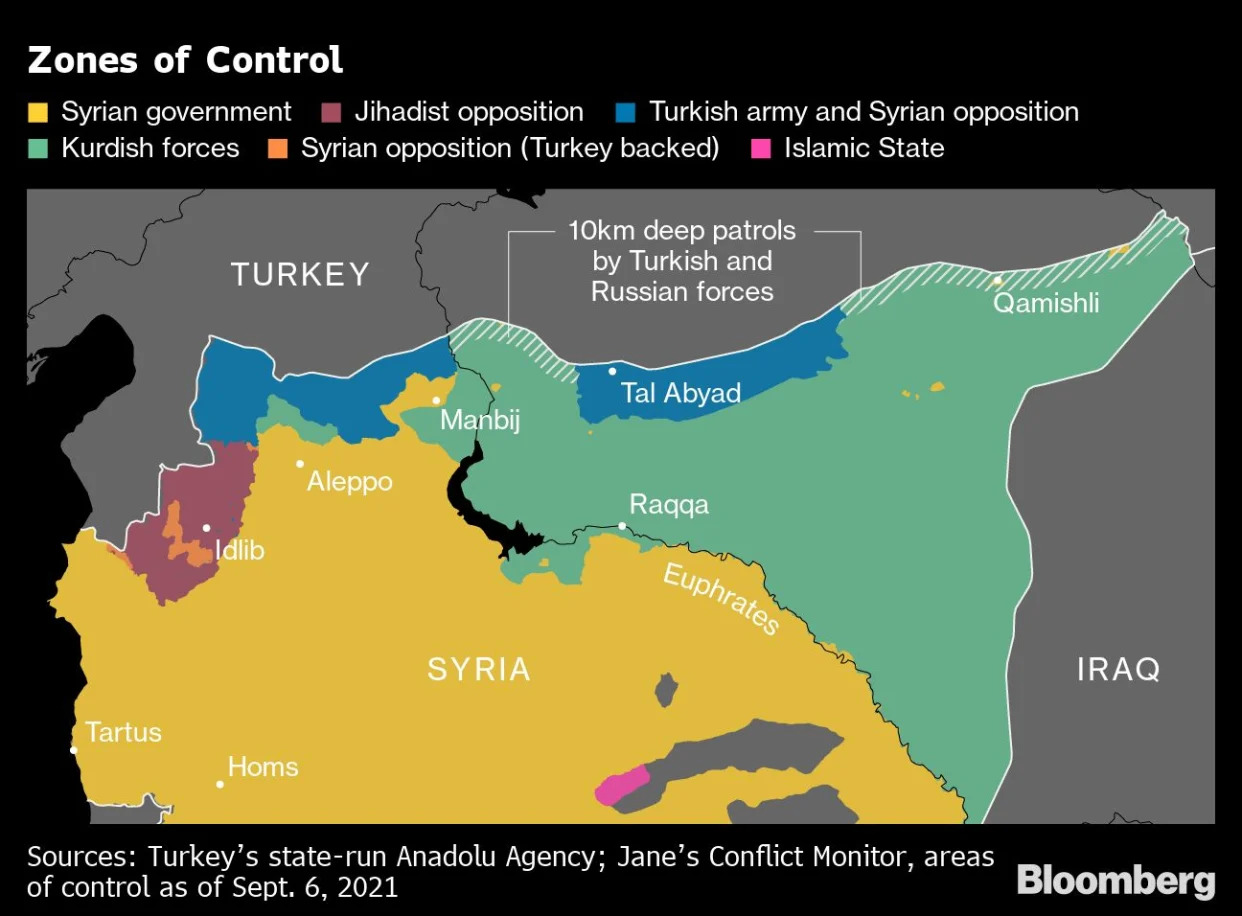
(Bloomberg) -- Turkey called on the US to stop working with Kurdish YPG militants in Syria, vowing to maintain its cross-border offensives against America’s Kurdish allies in Syria after the US shot down a Turkish drone in the region.
Turkish Foreign Minister Hakan Fidan told US Secretary of State Antony Blinken “with strong expressions that the US, as an ally, should stop working with the terrorist organization YPG in northern Syria, ” according to a readout statement from Turkey’s Foreign Ministry.
Turkey has since 2015 urged Washington to stop arming and training Kurdish YPG militants, allied with the US forces against Islamic State in Syria, that Turkey sees as terrorists. Turkey conducted retaliatory airstrikes against YPG militants in northern Syria on Thursday, during which an American F-16 jet shot down a Turkish drone that flew to within half a kilometer of US forces in Syria, a rare instance of two NATO allies coming into conflict and which led the lira to weaken.
“Turkey’s counter-terrorism operations in Iraq and Syria will continue with determination,” Fidan said during the call with Blinken on Friday, referring to Turkish airstrikes in reprisal for a suicide-bomb attack in Ankara over the weekend which Turkish intelligence said was carried out by Kurdish militants from Syria.
Turkey views the YPG, thought to have tens of thousands of fighters, as a security threat due to its ties to the PKK — a separatist group that’s based in Iraq and deemed a terrorist organization by the US and European Union.
Fidan and Blinken agreed that an existing de-escalation mechanism between Turkish and US forces in Iraq and Syria should be effectively operated “in a way that would not hinder” Turkey’s fight against terrorism, the readout said, referring to downing of the Turkish drone. The US, for its part, has warned Turkey against unilateral airstrikes that could threaten American personnel.
Turkey Terror Attack Spells Trouble for NATO: Mideast Briefing
The unmanned aircraft was operated by Turkey’s National Intelligence Agency, which was conducting cross-border operations in retaliation for a suicide-bomb in the Turkish capital on Sunday. The attack, which injured two security officers, was claimed by Kurdish militant group PKK and organized from Syria, according to Turkish intelligence.
Earlier on Friday, the Turkish Foreign Ministry acknowledged that the armed drone belonged to Turkey. In a written statement, it said the drone “was lost over differences in technical assessments... with third parties.”
US Defense Department spokesman Brigadier General Pat Ryder said there was no sign the drone planned to strike American troops. Nonetheless, Turkey’s operations have stoked fresh tensions with Washington, which supports Kurdish forces who it says have played a major role in the US-led effort to defeat the Islamic State.
Ties between the two NATO allies have recently come under more strain, with Turkish President Recep Tayyip Erdogan delaying Sweden’s entry to the North Atlantic Treaty Organization. Fidan and Blinken also discussed Sweden’s membership bid, the Turkish readout said without elaborating.
“Aerial operations were aimed at eliminating the terrorist threat emanating from northern Syria,” the Turkish Defense Ministry said.
US Shoots Down Turkish Drone That Approached Troops in Syria
US Defense Secretary Lloyd Austin urged de-escalation in a phone call with his Turkish counterpart, while acknowledging Turkey’s “legitimate security concerns,” the Pentagon said in a statement. He affirmed a commitment to close coordination with Ankara to prevent any risk to US forces in Syria.
Kurdish groups retain control over a large swathe of territory in Syria, which has been mired in a civil war since 2011.
Syrian President Bashar al-Assad’s Damascus-based government has largely consolidated its rule elsewhere in the country with the help of Russia and Iran. On Thursday, rebel forces hit a military academy in the Assad-controlled city of Homs, killing over 100 people, according to UK-based Syrian Observatory for Human Rights. Syria’s state-media put the number of dead at 80.
Read: All About the YPG, the Syrian Kurds Vexing Turkey: QuickTake
Turkey’s broader conflict with Kurdish militants has killed tens of thousands of people since 1984.
Turkey’s last major incursion into Syria took place in late 2019, with the stated aim of pushing armed groups away from the border. It later halted its operations following cease-fire agreements with the US and Russia.
Thursday’s air campaign also came as Turkey continues to insist on the full cooperation of Stockholm in cracking down on supporters of Kurdish militants within Sweden before approving its bid to join NATO.
Talks after US fighter jet shoots down armed Turkish drone in Syria
Thomas Mackintosh - BBC News
Fri, October 6, 2023
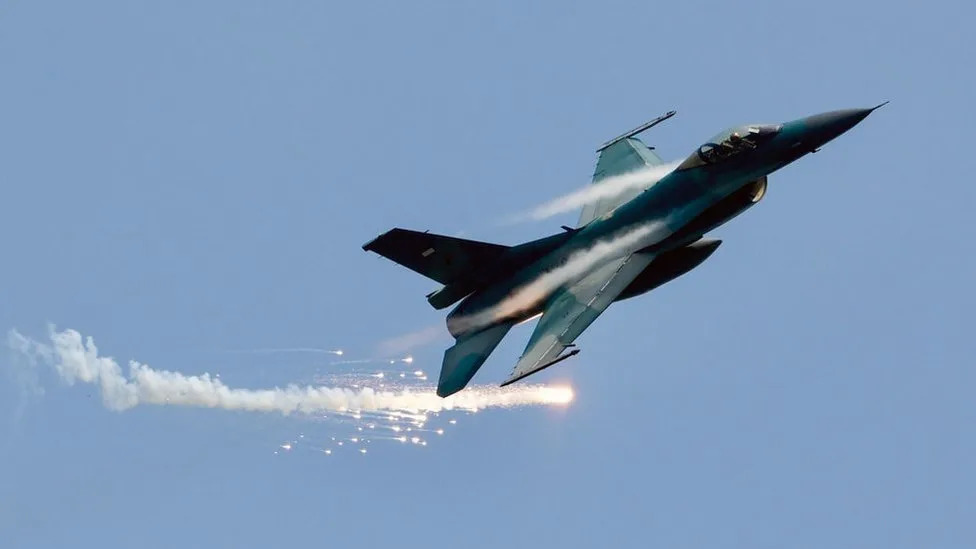
File photo of a US-made F-16 fighter jet plane
The top US and Turkish diplomats have spoken by phone after US forces in Syria shot down an armed Turkish drone.
Washington said the drone came too close to its ground forces in Syria, but Ankara merely said it was lost during operations.
During the call between the Nato allies, Hakan Fidan told the US Turkey would keep targeting Kurdish groups.
The US works with Kurdish YPG forces in Syria, but Turkey views them as separatists and terrorists.
Mr Fidan told US Secretary of State Antony Blinken that Turkey's "counter-terrorism operations in Iraq and Syria will continue with determination".
Meanwhile a US State Department spokesperson said Mr Blinken highlighted the need for Washington and Ankara to "coordinate and deconflict" their activities.
On Thursday US military officials said a US F-16 fighter jet shot down the armed Turkish drone which was operating near American troops in Syria after giving several warnings.
Pentagon spokesperson Brig Gen Patrick Ryder told reporters that American forces had observed several drones carrying out airstrikes near Al Hasakah in north-eastern Syria at 07:30 local time (04:30 GMT).
Some of the strikes were approximately 1km away from US troops, prompting them to take shelter in bunkers, Ryder said.
Four hours later, the F-16 downed the drone after commanders assessed there was a potential threat, he said.
"It's regrettable when you have two NATO allies and there's an incident like this," he told reporters.
It marked the first such incident between the two Nato allies.
There are about 900 US troops operating in Syria as a part of the mission against the Islamic State jihadist group (IS).
Turkey has been launching air strikes against Kurdish groups in Syria and Iraq after a suicide blast hit its interior ministry in Ankara.
The Kurdistan Workers Party (PKK) said the interior ministry bombing had been carried out by a group linked to them.
The PKK is considered a terror group in Turkey, the EU, UK and US.
Turkey views the PKK and the YPG as the same group. However the US has been working with the YPG, which is part of the group of US-backed forces known as the Syrian Democratic Forces (SDF) that has fought against IS in Syria.
Shortly after the phone call between Mr Blinken and Mr Fidan, Turkey said it had launched renewed attacks on Kurdish target in northern Syria.
The Turkish defence ministry said it had hit 15 Kurdish targets "with the maximum amount" of ammunition and they included "headquarters and shelters".
Who are the Kurds?
The PKK launched an armed struggle against the Turkish government in 1984, calling for an independent Kurdish state within Turkey.
In the 1990s, the PKK rolled back on its demands for an independent state, calling instead for more autonomy for the Kurds. More than 40,000 people have died in the conflict.
Fighting flared up again after a two-year-old ceasefire ended in July 2015.
View comments (16)
Turkey steps up strikes on militants as conflict escalates in Syria
Updated Fri, October 6, 2023
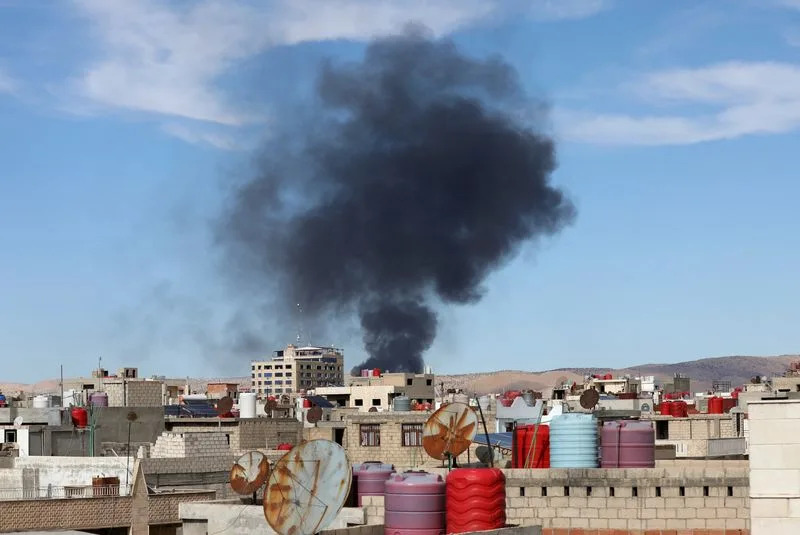
Smoke rises from Qamishli
By Daren Butler, Tuvan Gumrukcu and kilo
ISTANBUL (Reuters) -Turkish security forces attacked Kurdish militants in northern Syria and eastern Turkey, and Ankara said it will continue to destroy their capabilities across the region as conflict escalated on Friday nearly a week after a bomb attack in Ankara.
After U.S. forces shot down a Turkish drone in northern Syria on Thursday, Turkey confirmed the incident but assigned no blame, indicating it may want to contain any tensions with its NATO ally.
The military "neutralised" 26 Kurdish militants in northern Syria overnight in retaliation for a rocket attack on a Turkish base, the defence ministry said. Turkey typically uses the term "neutralise" to mean kill.
The rocket attack on the base, by the Syrian Kurdish YPG militia, killed one Turkish police officer and wounded seven officers and soldiers in northwest Syria's Dabiq area on Thursday evening, Ankara said.
Turkey also conducted air strikes and destroyed 30 militant targets elsewhere in northern Syria on Thursday night, including an oil well, a storage facility and shelters, the defence ministry said.
On Friday, the ministry said Turkey's military had conducted another round of air strikes in northern Syria and destroyed 15 other militant targets where it said militants were believed to be. It did not say where in northern Syria the strikes, carried out at 1900 GMT, had hit.
"As has been done in Iraq, all the capabilities and revenue sources developed by the terrorist organisation in Syria will continue to be destroyed in a systematic way," the foreign ministry said in a statement.
In Turkey, two Kurdistan Workers Party (PKK) militants were "neutralised" in eastern Agri province in a clash with commandos during an operation with combat drone and attack helicopter support, Interior Minister Ali Yerlikaya said in a statement.
He said counter-terror police detained 75 people suspected of links to the PKK in an operation across 11 provinces.
The PKK previously claimed responsibility for Sunday's bombing in Ankara that left the two attackers dead and wounded two police officers. Turkey said the attackers came from Syria but the Syrian SDF forces denied this.
TURKISH-U.S. TENSIONS
Turkey lists the YPG as a terrorist organisation and says it is indistinguishable from the PKK, which has fought an insurgency against the Turkish state since 1984 in which more than 40,000 people have been killed.
The United States and European Union deem the PKK as terrorists, but not the YPG.
The YPG is also at the heart of the SDF forces in the U.S.-led coalition against Islamic State militants. U.S. support for them has long caused tension with Turkey.
The SDF said Turkish attacks had killed eight people since the Ankara bombing.
Underscoring the tension, the Pentagon said the United States had on Thursday shot down an armed Turkish drone that was operating near its troops in Syria, the first time Washington has brought down an aircraft of NATO ally Turkey.
A Pentagon spokesman said Turkish drones were seen carrying out air strikes in Hasakah, northeast Syria, and one drone that came within less than half a kilometre (0.3 miles) from U.S. troops, was deemed a threat and shot down by F-16 aircraft.
The Turkish foreign ministry statement said one of Turkey's drones was lost during operations against Kurdish militants in northeast Syria due to "different technical evaluations" with third parties on the ground.
Without citing a specific country, it said it was working with the relevant parties on the ground to improve the functioning of non-conflict mechanisms on the ground.
Later on Friday, Turkish Foreign Minister Hakan Fidan held a call with U.S. Secretary of State Antony Blinken to discuss the downing of the drone, a Turkish Foreign Ministry source said.
"During the call, Minister Fidan conveyed to his counterpart Blinken in strong terms that, as an ally, the United States must stop working together with the YPG terrorist organisation in the north of Syria," the source said.
Fidan also told Blinken that Turkey's military operations in Syria would continue, the source said. The two ministers agreed to work on non-conflict mechanisms between the allies in Syria and Iraq in a way "that will not pose an obstacle to our counter-terrorism battle" after the drone was downed, the source added.
A State Department spokesperson said Blinken highlighted the need for Washington and Ankara to "coordinate and deconflict" their activities on the call.
Ankara, which has said all PKK and YPG targets in Syria and Iraq ARE now "legitimate targets" for its forces, said on Thursday a ground operation into Syria was one option it could consider.
Turkey has mounted several previous incursions into northern Syria against the YPG.
(Reporting by Daren Butler, Tuvan Gumrukcu, and Huseyin Hayatsever; Editing by Jonathan Spicer, Nick Macfie, Andrew Heavens and Sandra Maler)
View comments (7
Turkish warplanes hit Kurdish militia targets in northern Syria after US downed Turkish armed drone
SUZAN FRASER
Updated Fri, October 6, 2023
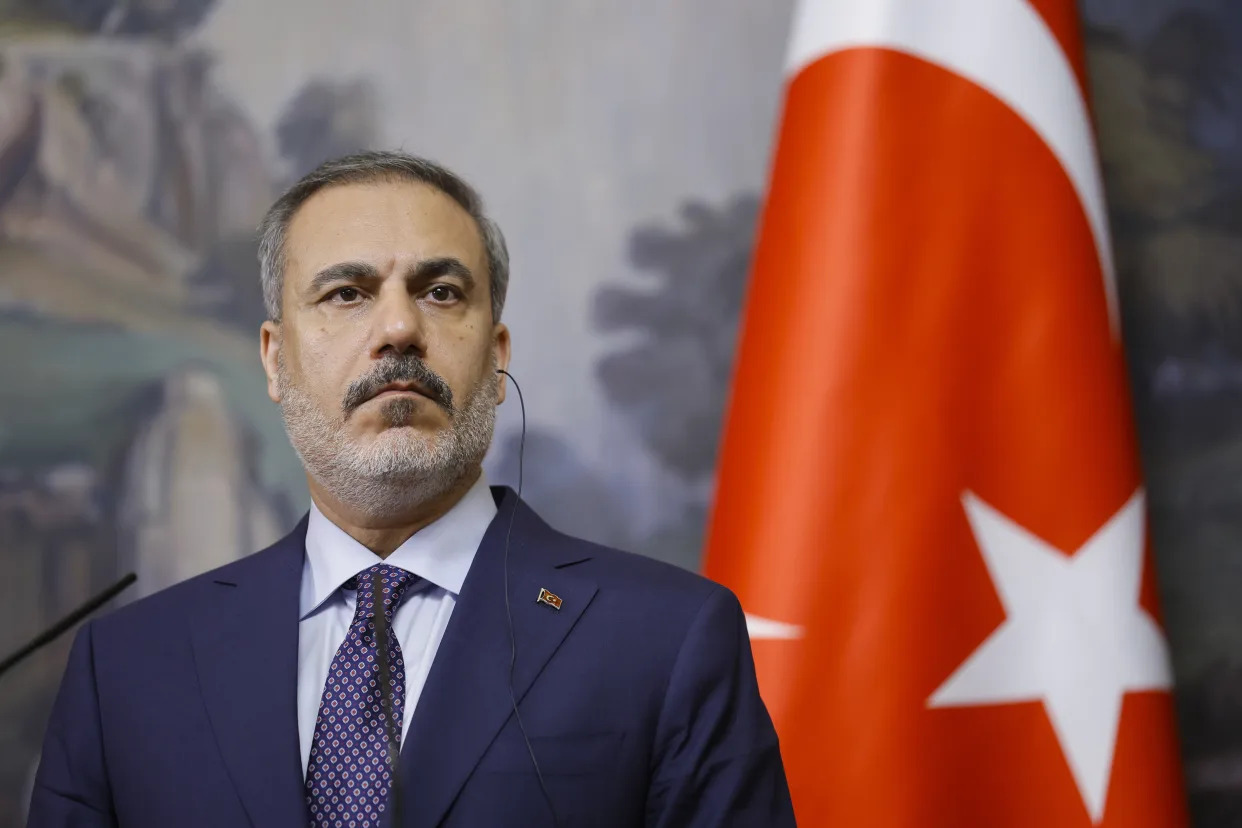
Turkish Foreign Minister Hakan Fidan attends a joint press conference with Russian Foreign Minister Sergey Lavrov in Moscow, Russia, on Aug. 31, 2023. Fidan warned on Wednesday Oct. 4, 2023 that Kurdish militants behind a suicide bombing in the Turkish capital face robust retaliation against their group’s positions in Syria and Iraq.
ANKARA, Turkey (AP) — Turkish warplanes have carried out airstrikes on sites believed to be used by a U.S.-backed Kurdish militia in northern Syria, after the U.S. military shot down an armed Turkish drone that came within 500 meters (yards) of American troops, officials said Friday.
A Turkish defense ministry statement said the Turkish jets targeted some 30 sites in the Tal Rifat, Jazeera and Derik regions, destroying caves, bunkers, shelters and warehouses.
Ankara said the locations were used by Kurdistan Workers’ Party, PKK, a designated terrorist group behind a decadeslong insurgency in Turkey — as well as its allies from a Kurdish militia in Syria, known as People’s Defense Units, or YPG.
The YPG is part of Syrian Kurdish-led forces — known as the Syrian Democratic Forces — backed by the United States. The Syrian Kurdish fighters have been close U.S. allies in the war against the militants from the Islamic State group.
Turkey has been carrying out strikes on Kurdish targets in Iraq and Syria following a suicide bombing outside the Interior Ministry building in Ankara, the Turkish capital, early on Sunday.
The PKK claimed the attack in which one attacker blew himself up and another would-be bomber was killed in a shootout with police. Two police officers were wounded.
Turkish Foreign Minister Hakan Fidan has said the two assailants had arrived from Syria, where they had been trained. He said PKK and YPG positions in Iraq and Syria have now become legitimate targets.
Kurdish authorities in northeastern Syria said the Turkish bombing killed 15 people, including eight civilians. Several others were wounded.
The U.S.-backed and Kurdish-led Syrian Democratic Forces in northeastern Syria have denied any connection to the Ankara attack and accused Turkey of using the attack as a pretext for a new military incursion.
In Washington, the Pentagon said Thursday that a Turkish drone bombed targets near the U.S. troops in Syria, forcing them to go to bunkers for safety. Air Force Brig. Gen. Patrick Ryder, the Pentagon press secretary, said the decision to shoot down the drone of a NATO ally “was made out of due diligence and the inherent right of self-defense to take appropriate action to protect U.S. forces.” There was no indication that Turkey was intentionally targeting U.S. forces, he said.
Turkey's Foreign Ministry on Friday blamed the downing of the drone on differing evaluations of what it called a “deconflicting mechanism” operated between the sides. Necessary measures were being taken to ensure a “more effective operation” of the mechanism, the ministry said without elaborating.
“The incident did in no way affect the execution of the ongoing operation and the strikes against targets that were identified,” the ministry said.
Both Defense Secretary Lloyd Austin and the new Joint Chiefs chairman, Gen. CQ Brown, spoke with their Turkish counterparts quickly after the incident to emphasize the value they place on their relationship with Turkey — but also the need to avoid any similar incidents in the future and ensure the safety of U.S. personnel.
On Friday, Foreign Minister Fidan held a telephone call with U.S. Secretary of State Antony Blinken, during which he reiterated Turkey’s belief that as an ally, the U.S. should stop working with the Kurdish militia, Turkey's state-run Anadolu Agency reported.
The minister also told his American counterpart that Turkey’s counter-terrorism operations in Iraq and Syria would continue “with determination,” the news agency said.
The U.S. has about 900 troops in Syria conducting missions alongside Syrian Kurdish forces to counter IS militants.
The downing of the Turkish drone occurred as a drone attack killed at least 89 people in the Syrian government-controlled city of Homs on Thursday. In that attack, explosive-laden drones were detonated during a military graduation ceremony attended by young officers and their families. An additional 277 people were injured, according to Syria’s health ministry.
Syria’s military blamed insurgents “backed by known international forces,” without naming any particular group, and threatened to respond with “full force.”
The Turkish defense ministry said Thursday’s aerial operation in Syria was aimed at securing Turkey’s borders from threats from the PKK and YPG.
Separately, the ministry said Turkey had retaliated to an attack on a Turkish base in the Dabik region in northern Syria late on Thursday, “neutralizing” 26 attackers.
Meanwhile, Anadolu Agency said Friday that Turkish intelligence agents killed a PKK militant in an operation in Iraq’s Sinjar region. The agency identified him as Ilyas Biro Eli and said he was responsible for an alleged assassination unit.
“We will continue to fight terrorism wherever it emanates from. We will extinguish it at its sources, be it in northern Iraq or northern Syria,” wrote Fahrettin Altun, Turkey's presidential communications director.
The PKK has led a decades-long insurgency in Turkey and is considered a terror organization by Turkey's Western allies, including the U.S. Tens of thousands of people have died since the start of the conflict in 1984.
The U.S., however, regards the YPG as a key partner in the fight against the IS and does not believe the group presents a threat to Turkey.
___
Associated Press writer Abby Sewell in Beirut contributed to this report.
Turkey bombs northeast Syria, hits energy sites: Kurds
AFP
Fri, October 6, 2023
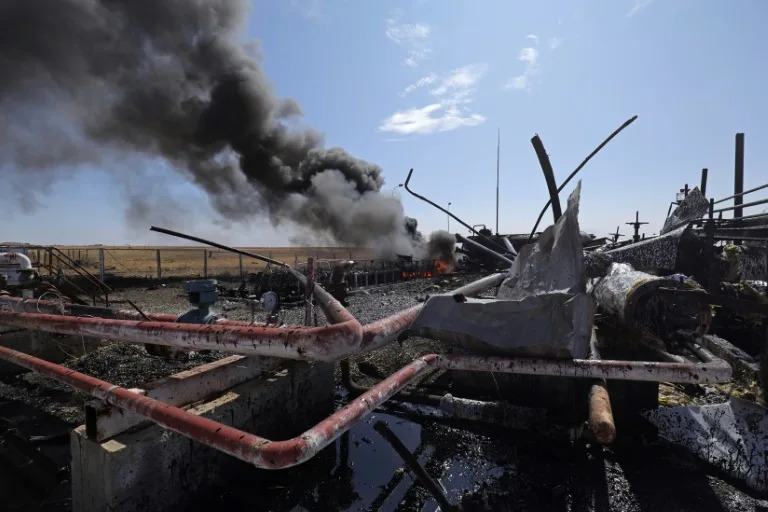
Smoke billows from the Babasi oil facility in Syria's Kurdish-controlled northeastern Hasakeh province following a Turkish strike (Delil souleiman)
Turkey resumed strikes against Kurdish-held northeast Syria on Friday, targeting energy infrastructure as the death toll climbed to 15 over two days, officials in the Kurds' semi-autonomous administration said.
Since Thursday, Turkey has carried out drone strikes against military sites and civilian facilities in the area following a weekend bombing in Ankara.
The toll in northeast Syria has risen to 15 dead including eight civilians, a statement from the US-backed, Kurdish-led Syrian Democratic Forces (SDF) said.
SDF spokesman Farhad Shami said that "since Thursday morning, we have counted more than 50 air strikes", adding that Friday's raids also targeted a gas plant near the Turkish border.
Akram Sulaiman, a local energy official, called the plant a "strategic facility" involved in feeding power to factories and hospitals in the area.
He said strikes Thursday also caused malfunctions at a power station serving neighbourhoods in Hasakeh city and its surroundings, and at another powering half the city of Qamishli further north.
Strikes also caused an outage at a station powering the nearby border city of Amuda, he added.
On Thursday, Turkish drones also targeted oil facilities and three Kurdish security forces sites, according to the Kurdish authorities.
Thick black smoke billowed from two oil sites targeted overnight, AFP correspondents said on Friday.
The bombardment comes after an attack in Ankara on Sunday wounded two security officers and was claimed by a branch of the banned Kurdistan Workers' Party (PKK), which Ankara and its Western allies view as a terrorist organisation.
Turkish Foreign Minister Hakan Fidan had warned of reprisals against Kurdish fighters in northeastern Syria, saying the assailants "came from Syria and were trained there".
The US-backed SDF, which spearheaded the fight in Syria against IS, denied the Ankara assailants had passed through the area.
Turkey views the Kurdish People's Protection Units (YPG) that dominate the SDF as an offshoot of PKK.
Pentagon spokesman Pat Ryder said US F-16 warplanes over Syria shot down a Turkish drone on Thursday, deeming it "a potential threat" after it approached "less than a half kilometre from US forces" near Hasakeh.
Since 2016, Turkey has carried out successive ground operations to expel Kurdish forces from border areas of northern Syria, and has made threats of a new incursion.
rh/srk/lg/it
Turkish airstrikes kill at least 11 in northern Syria, Kurdish security forces say
Thu, October 5, 2023
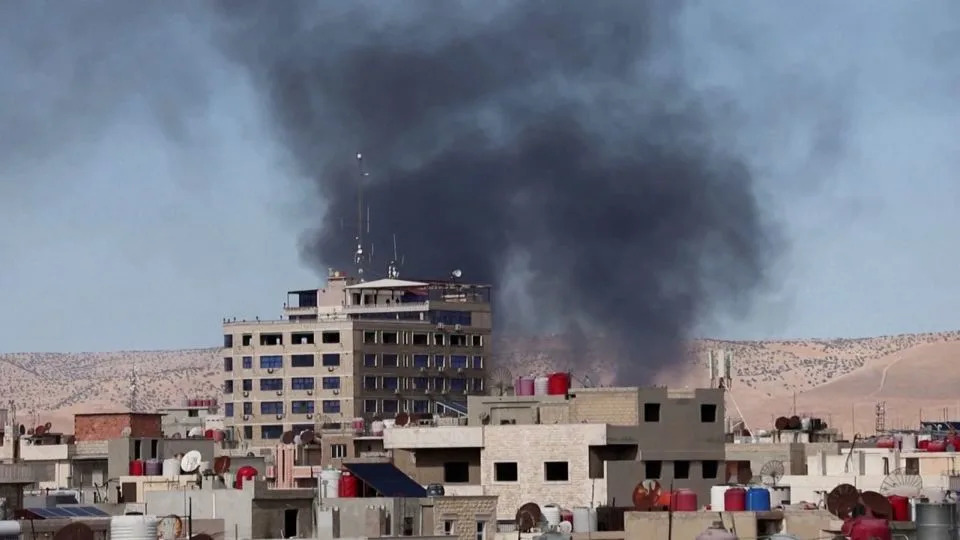
Reuters
Turkish airstrikes killed at least 11 people in multiple Kurdish-controlled locations in northeastern Syria, the Kurdish Internal Security Force said Thursday, the latest response from Ankara’s forces following a bomb attack in Turkey’s capital claimed by Kurdish militants.
In a post on its official website, the Kurdish Internal Security Force, known as Asayish, said the locations targeted by Turkey included the vicinity of a camp for displaced people and several villages.
“Eleven people were martyred, including five civilians and six members of the Internal Security Forces,” Asayish said.
Eight civilians and two members of the Kurdish security forces were wounded, it added.
In a statement Friday, Turkey’s Defense Ministry said it destroyed 30 targets and “neutralized” multiple Kurdistan Workers’ Party (PKK) militants during the operation in northern Syria, citing its self-defense rights from Article 51 of the United Nations Charter to justify the strikes.
The strikes come after a bombing in Ankara over the weekend claimed by the PKK, which has waged a nearly four-decade long insurgency and is classified as a terrorist organization by Turkey, the United States and the European Union.
At least one civilian was killed in the attack Sunday when militants hijacked a car, and two police officers were injured in the bombing outside Turkey’s Interior Ministry building.
Later Sunday, the Turkish Defense Ministry said its warplanes had destroyed 20 PKK targets in northern Iraq in response to the attack.
According to Ankara, the PKK trains separatist fighters and launches attacks against Turkey from its bases in northern Iraq and Syria, where a PKK-affiliated Kurdish group controls large swaths of territory.
“In the investigation following the latest incident, it was determined by security forces and intelligence that the terrorists came from Syria and were trained there,” Turkish Foreign Minister Hakan Fidan told a news conference on Wednesday.
Fidan warned that all facilities belonging to the PKK and related People’s Protection Units (YPG) groups in Iraq and Syria would be “legitimate targets” of the Turkish Armed Forces.
“The response of our armed forces to the terror attack will be very clear and they will once again regret having carried out this attack,” Fidan said.
Kurds, who do not have an official homeland or country, are the biggest minority in Turkey, making up between 15% and 20% of the population, according to Minority Rights Group International.
Portions of Kurdistan – a non-governmental region and one of the largest stateless nations in the world – are recognized by Iran, where the province of Kordestan lies; and Iraq, site of the northern autonomous region known as Kurdistan Regional Government (KRG) or Iraqi Kurdistan.
In recent years, Turkey has carried out a steady stream of operations against the PKK domestically as well as cross-border operations into Syria.
In November 2022, Ankara blamed the PKK for a bomb attack in Istanbul that killed six and injured dozens.
Terror attacks in Turkey were tragically common in the mid to late 2010s, when the insecurity from war-torn Syria crept north above the two countries’ shared border.
CNN’s Hande Atay Alam contributed reporting.
U.S. shoots down Turkish drone as Turkey conducts strikes in Syria
Patrick Hilsman
Thu, October 5, 2023
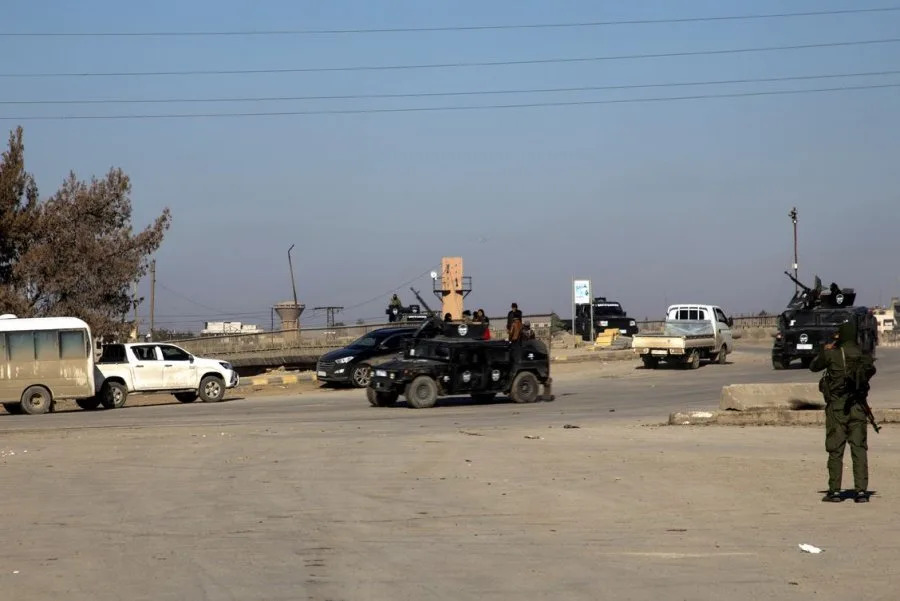
Turkey accuses the U.S.-backed, Kurdish-led Syrian Democratic Forces (pictured in 2022), who fought against ISIS militants in Syria with American support, of being linked to the Kurdistan Workers' Party, which is considered a terrorist organization by Turkey. File Photo by Ahmed Mardnli/EPA-EFE
Oct. 5 (UPI) -- The U.S. military shot down a Turkish drone over the Kurdish-led Syrian Democratic Forces-controlled zone in northeaster Syria's Al-Hasaka province Thursday, according to multiple news reports citing unnamed officials.
The incident came as Turkish forces targeted civil installations and oil facilities in Hasaka along with multiple other sites Thursday, according to local authorities.
"The Turkish State is committing a war crime by targeting the infrastructure and civil services facilities, including four power stations, three oil fields, and factories. The most heavily impacted by these aggressions are primarily innocent civilians," Syrian Democratic Forces spokesperson Farhad Shami posted to X Thursday.
"The Turkish UAV attacks resulted in a total of nine martyrs, comprising three civilians and six members of the Internal Secuity Forces who were guarding the targeted civic facilities. The Turkish State is publicly practicing state terrorism," Shami continued.
The strikes follow an attack in the Kurdish city of Ankara Sunday, which was claimed by the PKK (Kurdistan Workers' Party) militant group, which is considered a terrorist organization by Turkey, and has been engaged in a conflict with the Turkish state for decades, demanding autonomy for Turkey's Kurdish population.
On Sunday, the Turkish military conducted airstrikes in Iraq against targets the Turkish Minster of Defense said were linked to the PKK.
The Saudi Arabian state-backed outlet Al-Monitor reports that the drone was brought down on Thursday was shot down by an American F-16.
Turkey accuses the U.S.-backed, Kurdish-led Syrian Democratic Forces, who fought against ISIS militants in Syria with American support, of being linked to the PKK.
Several hundred U.S. troops are based in Northeastern Syria, operating in coordination with the SDF, in continued military operations against ISIS.
On Wednesday, Turkish officials called PKK and SDF-linked installations "legitimate targets."
CBS reports that U.S. forces issued multiple warnings to the Turkish military, before opening fire on the UAV.
Late Thursday, the Pentagon said U.S. Secretary of Defense Lloyd J. Austin III spoke by phone with Turkish Minister of National Defense Yasar Guler in the wake of the incident.
Austin urged a de-escalation in northern Syria and stressed the importance of maintaining strict adherence to "de-confliction protocols and communication" through established military channels, Pentagon press secretary Brig. Gen. Pat Ryder said.
Both leaders reiterated a "shared commitment to defeating ISIS," Ryder said in a statement, adding that Austin acknowledged Turkey's legitimate security concerns.
US fighter jet downs a drone belonging to NATO ally Turkey over Syria, officials say
Natasha Bertrand and Oren Liebermann, CNN
Thu, October 5, 2023
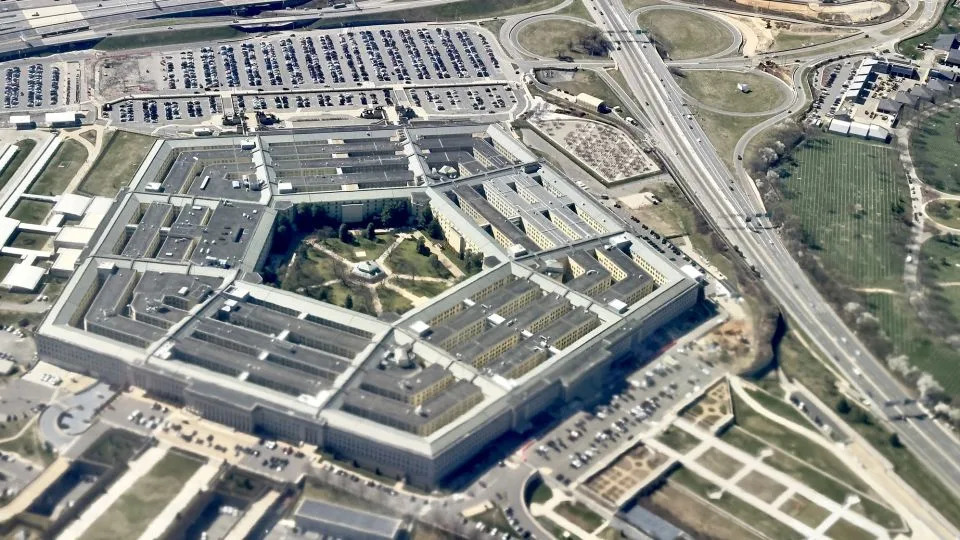
Daniel Slim/AFP/Getty Images/FILE
A US F-16 fighter jet shot down an armed Turkish drone in northeast Syria that was operating near US military personnel and Kurdish Syrian Democratic Forces, officials familiar with the incident told CNN.
The US assessed the armed drone posed a potential threat and issued more than a dozen warnings before shooting it down, the officials said. It is unclear how the warnings were issued. US forces exercised their right to self-defense in shooting down the drone, officials said.
There were no reports of US casualties, an official said.
Several drones made repeated approaches toward US troop positions in Hasakah, Syria, the officials said. Turkish airstrikes targeted several Kurdish-controlled areas in northeastern Syria on Thursday, killing at least eight people, including six security forces, and wounded three civilians, according to a statement by Kurdish Internal Security Force, Asayish.
The incidents put the US in a precarious position. Turkey is a NATO ally and a critical partner for the US in the region, as well as playing a key role in the Ukraine conflict. At the same time, the SDF partners with the US in the campaign to defeat ISIS.
The Turkish Defense Ministry said the drone didn’t belong to the Turkish armed forces, Reuters reported. CNN is reaching out to the Turkish government.
Defense Secretary Lloyd Austin spoke with his Turkish counterpart following the downing of the drone.
“The Secretary reaffirmed that the United States remains in Syria exclusively in support of the campaign to defeat ISIS,” Pentagon spokesman Brig. Gen. Pat Ryder said on Thursday afternoon. “The Secretary also acknowledged Turkey’s legitimate security concerns and underscored the importance of close coordination between the United States and Turkey to prevent any risk to US forces or the global coalition to defeat ISIS mission.”
Chairman of the Joint Chiefs of Staff Gen. CQ Brown also spoke with his Turkish counterpart following the incident, and discussed “the need to follow common deconfliction protocols to ensure the safety of our personnel in Syria following today’s incident,” according to a readout of their call.
Ryder said the unmanned aerial vehicle, or UAV was “conducting airstrikes,” some of which were inside “a declared US restricted operating zone” near US forces. Those forces were relocated to bunkers, Ryder said.
“US commanders assessed that the UAV, which was now less than a half kilometer from US forces, to be a potential threat, and US F-16 fighters subsequently shut down the UAV in self-defense at approximately 1140 local time,” Ryder said. “It’s important to point out that no US forces were injured during the incident.”
He said there were “no initial indications that Turkey was intentionally targeting US forces.” Ryder added that it was a “regrettable incident” but described Austin’s phone call as a “very productive discussion.”
US forces operate closely alongside the Kurds in northern Syria as part of the anti-ISIS coalition there. Turkey considers the Kurdish forces to be a terrorist organization and regularly targets them inside Iraq and Syria.
Turkey’s Foreign Minister Hakan Fidan said on Wednesday that Turkey considers all Kurdish militia facilities and infrastructure in Syria and Iraq as “legitimate targets” after the Kurdistan Workers Party carried out a suicide attack in Ankara on Sunday.
Fidan added that “third parties” should stay away from the Kurds.
“I advise third parties to stay away from PKK and YPG facilities and individuals,” he said. “Our armed forces’ response to this terrorist attack will be extremely clear and they will once again regret committing such an action.”
Last November, a Turkish drone strike in northeast Syria endangered US troops and personnel, according to the US military. That prompted a call between the top US general and his Turkish counterpart.
The strike targeted a base near Hasakah, Syria, used by US and coalition forces in the ongoing campaign to defeat ISIS. The Kurdish-led Syrian Democratic Forces (SDF) said two of their fighters were killed in the attack. The strike earned a stern rebuke from the Pentagon, which said it “directly threatened the safety of US personnel.”
CNN’s Haley Britzky and Michael Conte contributed to this report.
